1. Autism
1.1. affects
1.1.1. Verbal and non verbal communication
1.1.2. social interraction
1.2. accommodation
1.2.1. small groups
1.2.2. separate space
1.2.3. routine
1.2.4. agenda with deadlines
1.3. output
1.3.1. mindmaps
1.3.2. multiple choice format
1.3.3. pointing right answer on computer
1.4. case study
1.4.1. http://www.kidsmatters.com.au/wp-content/uploads/2014/08/Case-Study-Cameron-3.pdf
2. Intellectual Disabilities
2.1. affects
2.1.1. general intellectual function
2.2. accomodation
2.2.1. quiet work space
2.2.2. functional activities
2.2.3. hands on learning
2.2.4. daily repetition of concepts
2.3. modifications
2.3.1. student/teacher ratio
2.3.2. safety measures
2.3.3. schedule
3. Emotional disturbance
3.1. case study
3.1.1. http://cecp.air.org/fba/problembehavior3/appendixb1.htm Tom -Tourette syndrom
4. Developmental Delay
4.1. affects
4.1.1. physical development
4.1.2. cognitive development
4.1.3. social and emotional development
4.1.4. adaptative behavior
4.2. accomodation
4.2.1. seating arrangement
4.2.2. routine/ predicatability
4.2.3. use of age appropriate materials
4.3. output
4.3.1. visual timer
4.3.2. daily planner
4.4. modification
4.4.1. teacher/student ratio
5. Multiples disabilities
5.1. affects
5.1.1. speech or communication
5.1.2. sensory skills
5.1.3. behavior
5.2. modification
5.2.1. special education class
5.2.2. physical and occupational therapist
5.2.3. early concept development
5.2.4. mobility
5.2.5. environmental control
5.3. accomodation
5.3.1. assistive technology
5.3.2. leaning toys and software
5.3.3. switch options
6. Specific learning Disability
6.1. affects
6.1.1. auditory perception and processing
6.1.2. visual perception and processing
6.1.3. information processing speed
6.1.4. abstract reasonning
6.2. accommodation
6.2.1. advanced notice assignement
6.2.2. due date agenda
6.2.3. multi-sensoriel and hands-on activities
6.2.4. brief instructions
6.2.5. read aloud written instructions
6.2.6. study guide
6.2.7. peer notetaker/proofread
6.2.8. extra time for test
6.3. outputs
6.3.1. recording device
6.3.2. calculator
6.3.3. camera
6.3.4. audio books
6.4. case study
6.4.1. http://www.ldaofky.org/RTI/RTI%20Manual%20Case%20Studies.pdf Jayden p32- reading fluency and comprehension
6.4.2. http://images.pearsonassessments.com/images/ca/rti/downloads/Ellie.pdf -reading fluency and comprehension, writing expression, attention deficit disorder
6.4.3. http://images.pearsonassessments.com/images/ca/rti/downloads/Nick.pdf Nick- mathematical reasonning
7. Traumatic Brain Injury
7.1. affects
7.1.1. cognitive skills
7.1.2. psychosocial fonction
7.1.3. physical and motors skills
7.2. accommodation
7.2.1. additionnal time for assignement
7.2.2. additionnal help
7.2.3. extended break
7.2.4. written and oral instruction
7.2.5. study guide
7.2.6. preferential seating
7.2.7. multiple choice format
7.3. outputs
7.3.1. audio recorder
7.4. modification
7.4.1. reduce quantity of work
7.4.2. use of calculator
7.4.3. use of dictionnary
7.5. study case
7.5.1. http://scholar.lib.vt.edu/theses/available/etd-04262004-141714/unrestricted/Karenfinaletd.pdf Larry-p46 -speech/language and occupational therapy
8. Deaf-blindness
8.1. affects
8.1.1. hearing
8.1.2. vision
8.1.3. communication
8.2. accommodation
8.2.1. assistive listening device
8.2.2. interpreters
8.2.3. braille notetaker
8.2.4. reading machine
8.2.5. recording device
8.2.6. oral presentation
8.3. modification
8.3.1. oral test
8.3.2. safety measures
8.4. case study
8.4.1. http://www.med.unc.edu/ahs/clds/resources/deaf-blind-model-classroom-resources/db-case-studies/matthews-story-1
9. Deafness or Hearing Impairment
9.1. affects
9.1.1. hearing
9.1.2. processing linguistic information
9.2. accommodation
9.2.1. oral presentation
9.2.2. sign presentation
9.2.3. semi-circular seating in the classroom
9.2.4. flashing lights for class-schedule or alam
9.2.5. study guide
9.2.6. multi-sensori, hands-on activities
9.2.7. peer tutoring
9.3. outputs
9.3.1. hearing aids
9.3.2. overhead projector
9.3.3. graphic organizer
9.3.4. computer/word processor
9.3.5. extra time for assignement
10. Orthopedic Impairment
10.1. affects
10.1.1. fine motors skills
10.1.2. gross motor skills
10.1.3. neuro-motors skills
10.2. accommodation
10.2.1. seating arrangement
10.2.2. physical and occupational therapist
10.2.3. classroom space
10.3. modification
10.3.1. focus on motors skills
10.4. outputs
10.4.1. screen reading sofware
10.4.2. speech recognition sofware
10.4.3. augmentative communication device
11. Other health Impairment
11.1. affects
11.1.1. strenght
11.1.2. vitality
11.1.3. alertness
11.2. accomodation
11.2.1. availability of medication
11.2.2. rest time
11.2.3. ergonomic work station
11.3. output
11.3.1. assisting device
11.3.2. medical aid
12. Speech or language Impairment
12.1. affects
12.1.1. articulation
12.1.2. fluency
12.1.3. voice
12.2. accommodation
12.2.1. written assignement
12.2.2. extra time for expression
12.2.3. copy of lesson notes
12.2.4. minimize background noise
12.2.5. peer tutoring
12.3. outputs
12.3.1. speaking device
13. Visual Impairment including Blindness
13.1. affects
13.1.1. vision
13.1.2. oral and written comprehension
13.2. accommodation
13.2.1. objects models
13.2.2. peer note taker
13.2.3. oral description
13.2.4. braille
13.2.5. tactile graphics
13.3. modification
13.3.1. extra time for response
13.4. outputs
13.4.1. talking device
13.4.2. braille note-taker/refreshable
13.4.3. large screen/ low vision device
13.4.4. slate and stylus
